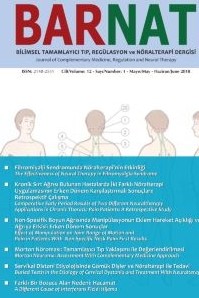İNFLAMATUVAR BAĞIRSAK HASTALIĞI REGÜLASYON TIBBI NÖRALTERAPİ YAKLAŞIMI
İnflamatuvar veya diğer adıyla iltihaplı bağırsak hastalığı terimi, Crohn hastalığı ile ülseratif koliti birleştirmek için kullanılır. Yaygın
semptomlar arasında ishal, bağırsaklarda kan kaybı ve karın ağrısı bulunur. Ancak genellikle iki hastalık ayırt edilebilir. Nedeni, mukozal
bağışıklık sisteminin bir "düzensizliğidir" (1).
İnflamatuar bağırsak hastalıkları (İBH), gastrointestinal kanalın çeşitli bölge ve katmanlarını tutabilen, kronik inflamasyonla seyreden
ancak etyopatogenezi henüz tam olarak açıklığa kavuşmamış bir hastalık grubudur (2).
İnflamatuar Bağırsak Hastalığı (İBH), gastrointestinal kanalın zor iyileşen mukoza ülserasyonlarıyla tetiklenen bağırsak inflamasyonuyla
karakterize kronik bir hastalığıdır.
Son yıllarda IBH tedavisi için TNF (tümör nekroz faktörü) alfa blokerleri gibi yeni ilaçlar onaylanmış olmasına rağmen, kronik bağırsak
iltihabını tamamen iyileştirmek nadiren mümkündür. İBH hastaları uzun süreli ilaç tedavisine rağmen düzenli alevlenmeleri kabul
etmek zorundadır. Bu yetersiz tedaviden dolayı regülasyon tıbbı, nöralterapi ve tamamlayıcı tıpa yönelim her geçen gün artmaktadır.
İBH’da tedavinin temelini belirtilerin ortadan kaldırılması, mukozal iyileşme ile remisyonun sağlanması, remisyonun devamı ve
rekürrensin önlenmesi oluşturur. Halen hastalığın tamamen iyileştirilmesi ve nükslerin önlenmesi sağlanamamıştır. IBH'de tedavide
medikal ve cerrahi yöntemleri kullanılmaktadır. Tedavide oral/rektal 5-aminosalisilatlar (5-ASA), steroidler, tiopürinler, takrolimus,
siklosporin gibi ilaçlar kullanılabilmektedir. Medikal tedaviye yanıtsızlık İBH’nda hala önemli bir sorundur (3,4-14).
Bütüncül Regülasyon tıbbı yaklaşımı ve nöralterapinin yanı sıra probiyotik, fitoterapi, ortomoleküler tıp desteği, piskoterapi, beslenme,
gıda duyarlılığı, entolarası tedaviye destek olarak ihtiyaç duyulmaktadır (14).
Nöralterapi çok düşük miktarda lokal anestezik madde (prokain veya lidokain) kullanılarak yapılan bir regülasyon tedavisidir. Nöralterapide
belli yerlere uygulanan lokal anestezik ajanlar ile vücutta vejetatif sistem üzerinden 3 ana sistem düzenlenir (15).
İnflamasyon ve Vejetatif (Otonom) Sinir Sistemi (VSS) arasındaki ilişki gösterilmeye başlandığından beri İnflamatuar Bağırsak Hastalığı
ile VSS arasındaki bağlantının da gösterilmesi araştırmacıların ilgisini çekmeye başlamıştır. Vejetatif disfonksiyonun düzeltilmesi üzerinde
en etkili tedavi yöntemi olarak Nöralterapi karşımıza çıkmaktadır (15).
INFLAMMATORY INTESTINAL DISEASE REGULATION MEDICINE; NEURALTHERAPY APPROACH
The term inflammatory, or inflammatory bowel disease, is used to describe both Crohn's disease and ulcerative colitis. Common
symptoms include diarrhea, blood loss in the intestines, and abdominal pain. However, generally two diseases can be distinguished.
The cause is a "disorder" of the mucosal immune system (1).
Inflammatory bowel diseases (IBD) are a group of diseases that can involve various regions and layers of the gastrointestinal tract,
progress with chronic inflammation, but the etiopathogenesis has not been fully clarified (Inflammatory Bowel Disease (IBD) is a chronic disease characterized by intestinal inflammation triggered by poorly healing mucosal
ulcerations of the gastrointestinal tract.
Although new drugs such as TNF (tumor necrosis factor) alpha blockers have been approved for the treatment of IBD in recent years,
it is rarely possible to completely cure chronic intestinal inflammation. IBD patients have to accept regular exacerbations despite
long-term medication. Due to this inadequate treatment, the trend towards regulation medicine, neural therapy and complementary
plug is increasing day by day.
The basis of treatment in IBD is the elimination of symptoms, providing remission with mucosal healing, continuation of remission and
prevention of recurrence. Currently, it has not been possible to completely cure the disease and prevent relapses. Medical and surgical
methods are used in the treatment of IBD. Drugs such as oral / rectal 5-aminosalicylates (5-ASA), steroids, thiopurines, tacrolimus,
cyclosporine can be used in the treatment. Unresponsiveness to medical treatment is still an important problem in IBD (3,4-14).
In addition to the holistic regulation medicine approach and neural therapy, probiotics, phytotherapy, orthomolecular medicine support,
psychotherapy, nutrition, food sensitivity, and inter-entotherapy are needed as support (14).
Neural therapy is a regulation therapy using very low amounts of local anesthetic agents (procaine or lidocaine). In neural therapy,
3 main systems are arranged through the vegetative system in the body with local anesthetic agents applied to certain places (15).
Since the relationship between Inflammation and the Vegetative (Autonomic) Nervous System (VSS) has begun to be demonstrated,
the demonstration of the link between Inflammatory Bowel Disease and VSS has attracted the attention of researchers. Neural
therapy emerges as the most effective treatment method for correcting vegetative dysfunction (15).2).
___
- 1. Martins NB, Peppercorn MA. Inflammatory Bowel Disease. Am J Manag
Care. 2004;10:544-552
- 2. Ardizzone S, Bianchi Porro G. Inflammatory bowel disease: new insights
into pathogenesis and treatment. Journal of Internal Medicine 2002; 252:
475–496
- 3. Stenson WF: Inflammatory bowel disease. In Goldman L, Ausiello D (eds):
Cecil textbook of medicine, 22nd edition.861-868,2004.
- 4. Loftus EV, Sandborn WJ. Epidemiology of inflammatory bowel disease.
Gastroenterol Clin North Am. 2002;31:1-20.
- 5. Sartor JR. Pathogenic and clinical relevance of cytokines in inflammatory
bowel disease. Immunol Res 1991; 10: 465-471.
- 6. Lobos EA, Sharon P, Stenson WF. Chemotactic activity in inflammatory
bowel disease. Role of leukotriene B4. Dig Dis Sci 1987; 32:1380-1388.
- 7. Institut für Epidemiologie, Uni Kiel, CED-Krankheitsbild, abgerufen am 13.
August 2020, https://www.epidemiologie.uni -kiel
- 8. J. Mulder, Angela J. Noble, Christopher J. Justinich, Jacalyn M. Duffin,
Geschichte zweier Krankheiten: Geschichte entzündlicher Darmerkrankungen,
Journal of Crohn’s and Colitis, Band 8, Ausgabe 5, 1. Mai 2014,
Seiten 341–348
